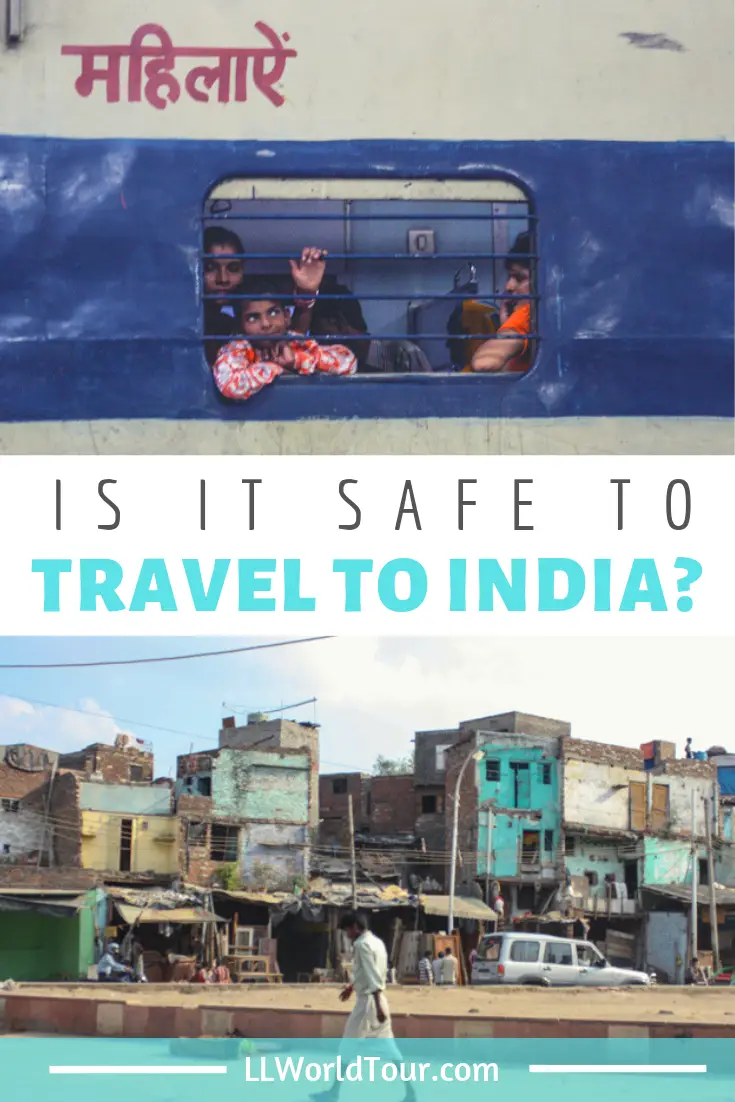[updated July 2019]
Wondering “should I visit India?” Or “is it safe to travel to India?” It may not be an easy place to visit, but that doesn’t mean you shouldn’t go. Here’s why.

There was an American man who had lived in Morocco on my tour around northwest India, and he had this to say about the experiences:
India and Morocco are trial by fire.
What he meant was, these are not easy places for many Westerners to visit. Obviously, this isn’t a failing on the part of the country, but it’s also not a failing on the part of the traveler.
If you don’t enjoy “trial by fire,” there’s nothing wrong with that. You don’t have to think of it as a grand adventure or love every minute of being outside your comfort zone. You get to choose where you travel. And that’s what this second post in my India series is all about.
Should I Visit India?
I spent three weeks in India, and I hope to see more of the country someday, but I would not recommend it to everyone. I think some places are more universally loved (by English-speaking Westerners) than others, in part, based on how relatively easy it is to just show up and have a good time.
Italy, for example, doesn’t let a lot people down. India, in my experience, is on the opposite end of the “relative ease” spectrum.
To help with this fact, I want to share my thoughts on what traveling in India is like for an English-speaking Westerner, and then you can decide for yourself if “trial by fire” sounds like your cup of tea.
The Cost of Traveling to India

When asking yourself ‘should I visit India?’ know that there are a few things to consider. Let’s start with an easy one. My flight to India (from Boston) cost more than $1,000, but the rest of the trip was almost laughably inexpensive. Almost every meal I ate, breakfast, lunch, and dinner, cost less than 250 rupees ($3.95).
Prices do vary depending on where you go, as they would in any country. For example, I was appalled to have to pay 800 rupees for lunch in Agra (home to the Taj Mahal and more expensive, as a result) until the other members of my tour group pointed out that it was still only $13. Then I realized I was being stingy (and rude).
That being said, “I can afford to go there” is not a good reason to travel somewhere. “I can afford it and it sounds interesting,” or “I can afford it and I’d like to learn the local language,” fine, but just, “I can afford it?” Nope.
Food Safety in India

The food may have been cheap, but it wasn’t always good. On my second full day in India, I wasn’t feeling overwhelmed. In fact, I was feeling cocky. I’m in my twenties, you see, so that means I’m invincible. Unsurprisingly, it was while I was feeling invincible that I ate bad samosas, got horrifically ill, and realized India did not care about all of my previous travel experiences nor the age of my stomach.
I’m sure some people go to India and have amazing foodie experiences, but I wasn’t one of them because my main priority had to be: Is this food safe?
Usually, I’m just concerned with whether it’s delicious. Now, I know the rules to staying healthy: no ice cubes, nothing uncooked, make sure street food is prepared in front of you, but I still slipped up and ordered bad samosas. It happens.
Other people on my tour spent much of the trip with mildly upset stomachs because the food was so different from what they normally ate or their stomachs were simply used to. It’s hard to travel in India without getting at least a little sick, even when your conscientious tour guide is taking you to restaurants that used filtered water in most of their food preparation.
Poverty and Beggars in India

Just as you have a strategy for dealing with poverty at home (whether or not you’ve thought of it in these terms), you should come up with a strategy for dealing with the poverty in India. Beggars will come up to you and ask for money, and sometimes they won’t stop asking until you walk away. Often these beggars will be children or women with babies on their hips. They will ask you for money or food or simply say, “please,” over and over again.
In general, I don’t give money to beggars and, in my opinion, you probably shouldn’t either. The practical reason is: if you give to one person, more people are going to converge on you.
A more sobering reason is human trafficking and forced begging, which exploits children as beggars because they attract more sympathy and money than adults, especially when they are kept looking filthy and underfed, or have physical disabilities. While not every child who asks for money has been trafficked, you don’t want to risk contributing to an economy of exploitation.
One day in Delhi, a little girl came up to an autorickshaw I was riding in with three other people from my tour group. We were stopped in traffic and she asked us for, “chocolate,” “money,” and “a black pen,” in that order. She was probably about 7 years old and I appreciated her priorities. Chocolate first, but if we didn’t have that, she’d take money. One of the other women in the autorickshaw rummaged around in her bag and handed the little girl a black pen. In response, the little girl skipped away joyfully. If child beggars break your heart, I don’t see much harm in giving them a pen.
Staring and Head Bobbles in India

In India, staring isn’t rude. If you don’t look like the average Indian person and you go out in public, you’re going to catch some people staring at you. If this makes you horribly uncomfortable, sorry, it’s a cultural norm.
Oftentimes when my tour group was stared at, we would just stare right back. The impulse to stare at people who look different from us can be strong, and it was sort of fun to embrace it. If we were feeling cheeky, we might throw in a head bobble, which usually made the Indian people staring at us laugh.
But what’s a head bobble, you ask? Sometimes when you ask a question or simply have a conversation with an Indian person, they will shake their head while they reply. It’s not a nod or a “no,” it’s a tilting of the head from side to side. It might mean, “yes,” or it might mean, “no,” or it might mean, “I’m not sure what you’re saying to me” or “what you’ve just said is offensive, but I’m being polite.” You get the idea. I had heard a lot about the head bobble before going to India from friends who had been there, so I expected to see it more often than I actually did.
Sexual Harassment in India

Is it safe to travel to India? Mostly, yes.
There has been some highly publicized violence against women in India, which has frightened people and hurt tourism to the country. Thankfully, I had no issues with sexual harassment during the three weeks I spent there. Maybe this is because I was with a tour group the majority of the time, but I can’t be sure.
Here are some top tips for women travelers visiting India.
Personally, I didn’t feel unsafe in India, but maybe it’s just that 20-something invincibility talking again.
Only one woman in my tour group (that I know of) was harassed — a man grabbed her butt as he walked by her on a crowded street. This kind of treatment isn’t limited to India, though. I’ve had my breasts and butt touched without my consent in Europe, and I think this kind of violence against women isn’t taken seriously in many countries.
Catcalling, leering, and groping are seen as something women have to put up with if we want to travel, and that’s not right.
I’m oversimplifying now but, I don’t think the problem is traveling to India, I think it’s a lack of respect for women’s bodily sovereignty all around the world.
Traveling to India is NOT a vacation

Let me repeat that, if you have two weeks worth of vacation time per year and you like to spend one of them relaxing in a foreign country, India is not a good choice.
India is crowded and, when you walk down the street, people are going to stare at you and ask you for money and invite you into their shop and ask where you’re from. And yes, all of these things will be happening at once.
When you need information, someone might reply with a head bobble, and you have to be careful what you eat, and although English is one of India’s official languages, it’s not always spoken widely or well, so don’t think you won’t encounter a language barrier. Not to mention, there’s a distinct lack of quality alcohol to help you cope with all of this.
If your image of India is one of yoga, serenity, and deeply spiritual people, banish that thought from your mind before you book a flight. There are places in India where you can get that kind of experience, and I share a few of them with you in the next post on northwest India, but don’t go to India thinking the whole country is a relaxing retreat because you are sorely mistaken and setting yourself up to be disappointed.
Pin it
: : :
Emma Holliday is a freelance writer and travel blogger. When she’s not busy wishing she were a polyglot, she’s backpacking Europe, working on an organic farm in Hawai’i, or drinking copious amounts of tea. Read more of Emma’s writing on her blog, An Opportune Moment.














 “So, how was your trip to India?”
“So, how was your trip to India?”

Hey Emma, this is not good to say India is not a good place to travel, you must have not found good guide to take you good places. There are countless places to see which you cannot forget for your whole life.
I didn’t say India wasn’t a good place to travel, and I certainly won’t ever forget some of the cities I visited and things I saw there. I’m very thankful to have visited. I just want Western tourists to think about what they want from their travels and choose destinations based on their needs.
I will instead visit the Philippines then…
Haha, you should visit whatever country/city you think you’ll enjoy the most!
Thank you for such a truthful post. And you are absolutely right! We haven’t visited India yet, but we are preparing ourselves for our visit by planning non-stressful stops before AND after! I really can’t express how great you post is. 🙂
Thank you for the high praise! I’m glad this post was useful and that it didn’t discourage you from going to India! I hope you have a great trip and I think non-stressful stops before and after will make the experience that much better. You won’t be burned out when you arrive and you’ll have ample time to reflect once you leave.
Thank you for sharing this great post. I really enjoyed reading it; it’s very informative with very nice pictures. keep up the great work!
I guess, in the end, it is a matter of preferences and costs 🙂
I love this post, and the way you covered various angles!